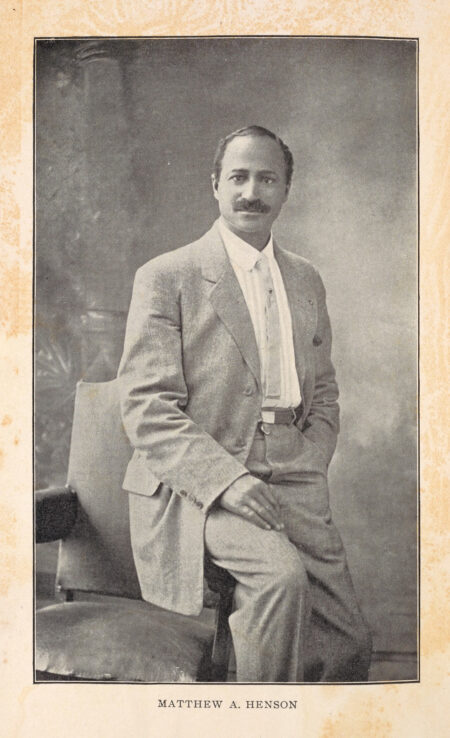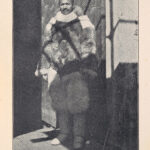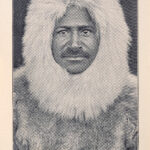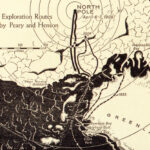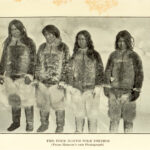Matthew Henson
Explorer
Modern
Quick Facts:
The first African-American to reach one of earth’s farthest places – the North Pole.
Introduction
The North Pole is one of the hardest places to reach, even still today, but especially over 100 years ago. The Polar region contains numerous dangers, harsh landscapes, and sub-zero temperatures. Matthew Henson, an African-American man, joined Robert Peary on his expedition to the North Pole in 1909. Early 20th century saw major racial issues, and Henson experienced many hardships in his life because of this. Despite racial challenges, Matthew Henson would go on to reach one of earth’s farthest reaches – the North Pole.
Biography
Early Life
Mathew Henson was born in Charles County, Maryland on August 8, 1866. This is one year after the end of the American Civil War, and so slavery was abolished in the United States. However, Henson’s parents were both free Blacks, therefore, Matthew Henson was born free.1 However, it was a divided time period, and families like Henson’s were often attacked and threatened by white supremacist groups. Due to these racial hostilities, Henson’s family was forced to leave their home, and move to Washington D.C. At 7 years old, Matthew Henson’s mother died, and he went to live with his uncle. Henson continued attending school until he was 13. He then left D.C. for Baltimore, Maryland where he became a cabin-boy onboard the Katie Hines. Over the next four years, Henson would visit many places including China, Japan, The Philippines in Asia; parts of North Africa; and Spain, France, and Russia in Europe.2
Matthew Henson quickly became a skilled sailor and explorer. But after the captain of the Katie Hines died, Henson returned to Washington D.C. in 1884. A few years later, in 1887 he would meet, and become friends with fellow explorer Robert Edwin Peary. This meeting would change the life and legacy of Matthew Henson. Together, he and Peary would go on to make history.
Voyages
Principal Voyage
In 1887, Matthew Henson met Robert Edwin Peary, an officer of the US Navy Corps of Civil Engineers. At first, Peary took Henson on as his personal valet. Basically Henson was Peary’s closest servant who attended to his needs. Henson accompanied Peary on a surveying expedition in 1888 to the jungles of Nicaragua. Although Henson started out as Peary’s valet, he soon earned a more challenging position as a chainman on the surveying team.3 A chainman held one end of a chain perfectly straight while the surveyor took sights on the other end. It was a very important job, one that required a steady hand, as even a small movement could cause an incorrect sighting. When their surveying expedition was completed, Peary spoke with Henson about the next great opportunity. A venture that would begin nearly a decade-long expedition in search of the North Pole.
Between 1889 and 1891, Henson worked in Philadelphia while awaiting a plan to begin their Arctic adventure. In 1891, he married Eva Flint. But Eva could not handle the long periods alone while Henson was exploring, so they later divorced. He went on later to marry Lucy Ross in 1907. He would set off with Peary on an expedition to Greenland and head north for the first time in 1891. At this time, not much was known about the Arctic regions. June 6, 1891, 23 year old Henson, Robert Peary, and the expedition set sail. They traveled from Brooklyn, New York on the Kite. On this trip, they encountered harsh arctic conditions. They reached Melville Bay, Greenland by July, where the Kite became trapped in the ice floe, a large sheet of ice surrounding the area. They would be stuck for nearly 3 weeks before being able to move on.4 During their time in Greenland, Henson met several local Inuit natives (formerly called Eskimo). He embraced their knowledge, and learned their language, a skill which would be handy in future Polar journeys. Over the next year, the teams would study and explore the areas around Greenland before returning home. Matthew Henson would join Robert Peary on several expeditions north between 1891 and 1906. But it was the journey for the pole between 1908 and 1909 that would bring both men to the top of the world.
Subsequent Voyages
July 6, 1908, Matthew Henson was on board the Schooner SS Roosevelt with Robert Peary and their team. Their journey would prove to be filled with dangerous conditions, and tragedy. They left from New York, traveling north, eventually reaching Etah, Greenland and then Cape Sheridan by September. Shortly after, they would continue their journey over the icy lands. Henson and Peary were joined by four native men – Ooqueh, Ootah, Egingwah, and Seeglo – and a team of sled dogs for the land portion of their adventure. March 16, 1909, they started over the ice. They traveled for days in harsh conditions, braving sub-freezing temperatures, and icy dangers. The ice of the Arctic does not always stay still, but rather will crack and shift with little warning. By April, Henson, Peary and their Inuit team were steadily moving across the icy landscape. At one point, while crossing a lane of moving ice, Henson fell into the freezing waters. He was unable to pull himself out. Thankfully, Ootah, one of the natives, grabbed Henson, and saved his life.5 This is just one of the near deadly encounters Henson experienced on his journey.
The expedition pressed on, with their hard work eventually paying off. On April 6, 1909, Robert Peary, with Matthew Henson and the four Inuit men reached the North Pole. They planted an American flag at the northernmost point of the globe, celebrating their historic achievement. They made notes and observations of the Polar lands, documenting the landscape along with their success. The next morning, they began the return journey back to the Roosevelt. They made it back to the ship with a sense of pride, and set sail from Cape Sheridan back home July 18, 1909. They stopped at Eagle Island, off the coast of Maine at the summer home of Robert Peary. They unloaded much of their gear before continuing on. From Eagle Island the ship steamed to Sandy Hook, New York, arriving at noon on October 2.6
Later Years and Death
Matthew Henson went back to a normal life after he returned home. Unfortunately, he did not get the recognition he deserved. For one thing, fellow explorer Dr. Frederick Cook, claimed he had reached the North Pole in April 1908 – a year before Peary and Henson. A great debate occurred to figure out which team had reached the pole first. Also, as an African-American in the early 20th century, Matthew Henson was not viewed fully as an equal in society. Therefore, Peary got much of the credit and attention for reaching the pole. Henson would go on to give lectures, and tell his story, and people would learn of his role. He later took a government job working at the U.S. Customs Bureau until he retired in 1940. Henson was honored a few years earlier in 1937 by being elected into the Explorers Club. The Explorers Club is a prominent international organization dedicated to the advancement of field exploration and scientific inquiry. Matthew Alexander Henson died in the Bronx, New York on March 9, 1955 at the age of 88. He and his second wife, Lucy, were buried at Woodlawn Cemetery. However, in 1988, both bodies were respectfully moved to Arlington National Cemetery. Here, he rests celebrated as a national hero to not just African-Americans, but all Americans.
Legacy
Matthew Henson is the co-discoverer of the North Pole. He was a man of many skills including craftsman, interpreter, and navigator. These skills were essential in his Polar success. Henson wrote his autobiography, A Negro Explorer at the North Pole, in 1912. He tells us in his own words about his experiences and the challenges he overcame that led him to his monumental achievement. He understood the magnitude of his accomplishment, and that he represented the possibilities for what all African-Americans could achieve.7 Today, we recognize Henson’s contributions to reaching the world’s northernmost point – the North Pole.
Images
- Matthew A. Henson in his North Pole furs after his return to civilization. The Mariners’ Museum G670 1909.P3 H5 Rare
- Matthew Henson stands in his furs on the “Roosevelt,” shortly before leaving the ship for the North Pole. The Mariners’ Museum E99.E7 C747
- Image of Matthew Henson after his return journey from the North Pole. The Mariners’ Museum G670 1909.P3 H5 Rare_123
- Map showing the Polar exploration routes of Matthew Henson and Robert Peary in 1982, 1906, and 1909. The Mariners’ Museum G635 H4 M5
- Copy of a photograph taken by Matthew Henson of the four Inuit who reached the Pole with Henson and Peary. The Mariners’ Museum G670 1909.P3 H5 Rare
Endnotes
- Matthew Alexander Henson, A Negro Explorer in the North Pole, (New York: Frederick A. Stokes, 1912), 3.
- Ibid, 3.
- Michael Gilman, Matthew Henson, (New York: Chelsea House Publishers, 1988), p. 25.
- William Herbert Hobbs, Peary, (New York: The MacMillan Company, 1936), p. 87.
- Henson, A Negro Explorer at the North Pole, 130 – 131.
- Ibid, 187 – 188.
- Ibid, p. 136

